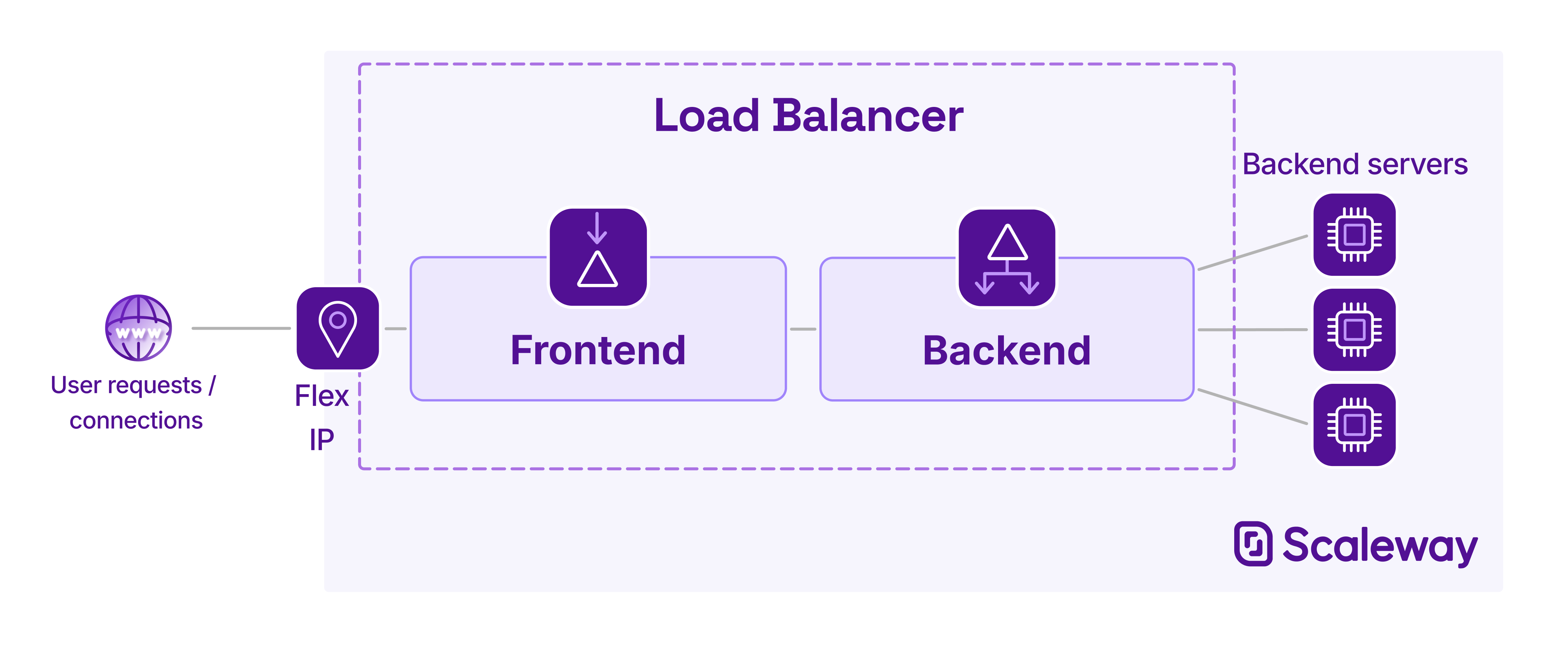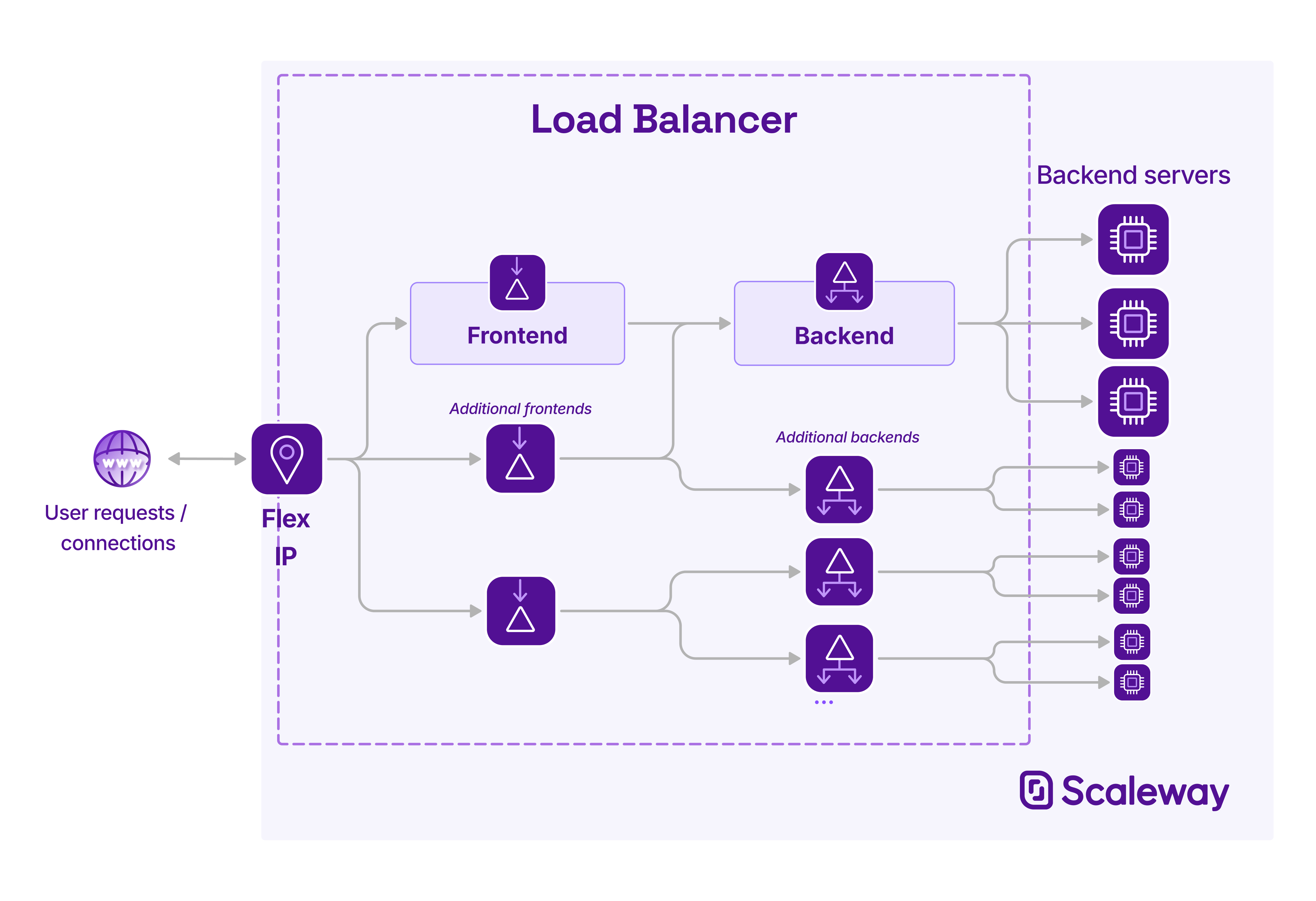Migrating from AWS to Scaleway for your load balancer needs
You may be used to creating and managing your cloud load balancers with AWS. This document is intended to help and guide users considering migrating from AWS to Scaleway for their load balancing needs. It aims to help you understand the differences and equivalences between load balancer concepts and resource creation with AWS versus Scaleway.
Load Balancer products and types
AWS offers several different "Elastic" Load Balancer products. Scaleway offers a single Load Balancer product, which can be configured in different ways to provide equivalences to the various types of AWS Elastic Load Balancer:
| AWS Classic LB | AWS Application LB | AWS Network LB | AWS Gateway LB | SCW LB | |
|---|---|---|---|---|---|
| OSI Layer | L4 & L7 | L7 | L4 | L3 & L4 | L4 & L7 |
| Protocols | HTTP, HTTPS, TCP | HTTP, HTTPS | TCP, TLS, UDP | All IP traffic | HTTP, HTTPS, TCP, TLS |
Key concepts and naming differences
AWS and Scaleway do not always use the same wording to describe similar Load Balancer features. The table below is designed to help you translate feature and concept naming from one cloud provider's load balancer product to another:
| AWS | Scaleway |
|---|---|
| Target group | Backend |
| Target | Backend server |
| Listener | Frontend |
| Listener rules | Routes |
| Listener rules | Routes |
| Internal Load Balancer | Private Load Balancer |
| Security group | ACL |
| Metrics with Amazon CloudWatch | Metrics with Scaleway Cockpit |
The diagram below shows the simplest form of Scaleway Load Balancer:

Scaleway Load Balancer features
Scaleway Load Balancer offers the following features:
Frontend:
- Public IPv4 and optional public IPv6 address (or private IP only)
- SSL/TLS certificate upload
- ACLs to filter incoming traffic
- HTTP/3 support
- HTTP Host header and SNI routes
Backend:
- HTTP, HTTPS, TCP, and TLS support
- Balancing between Scaleway resources (Instances, Elastic Metal servers, Dedibox) identified by public or private IP, or between non-SCW resources with selected plans
- Configurable balancing method: round-robin, least connections, first available
- Proxy Protocol
- Sticky sessions (IP-based or cookie-based)
- Customizable health checks
- Backend protection
- Customized error page
Other:
- Compatibility with Scaleway VPC
- Compatibility with Scaleway Kubernetes Kapsule and Scaleway CCM
- Caching and WAF via Edge Services
Load Balancer creation
AWS flow vs Scaleway flow
The process for creating a Scaleway Load Balancer is different to that of AWS. Whereas for AWS, you must first define the target group that the load balancer will forward traffic to, with Scaleway you begin by creating the Load Balancer itself and then define the target group (server IPs) during creation of the Load Balancer's backend.
| AWS | Scaleway |
|---|---|
| 1. Configure target group | 1. Create Load Balancer (AZ, commercial type, public and/or private IP) |
| 2. Choose and create load balancer type (Network / Application etc) | 2. Create and configure frontend (port) |
| 3. Configure load balancer and listener | 3. Create and configure backend (port, protocol, traffic management, backend server IP addresses, advanced settings, health checks) |
| 4. Configure additional settings (SSL/TLS certs, ACLs, routes, HTTP3, Edge Services, additional frontends and backends etc.) |
The full process of creating a Load Balancer with Scaleway is detailed in the Load Balancer Quickstart.
The diagram below shows a Scaleway Load Balancer with multiple frontends and backends. In this case, the frontends listen on different ports, and use routes to determine which of their attached backends to forward traffic to.

Application vs Network with Scaleway
To create the equivalent of an AWS Application Load Balancer with Scaleway, you will typically create a Load Balancer with:
- One or more frontends listening on port 80 or 443
- One or more backends configured for HTTP or HTTPS protocol
- (Optional) Routes from frontends to backends based on HTTP Host headers
To create the equivalent of an AWS Network Load Balancer with Scaleway, you will typically create a Load Balancer with:
- One or more frontends listening on a port matching your application
- One or more backends configured for TCP protocol
- (Optional) Routes from frontends to backends based on SNI
Plans and pricing
Like AWS, the pricing model for Scaleway Load Balancers is based on an hourly rate. Different commercial types of Load Balancers have different hourly rates, based on:
- Maximum supported bandwidth
- Multicloud support (whether the Load Balancer can forward traffic to backend servers outside of Scaleway)
For full pricing details, see our dedicated pricing page.
Useful documentation
To learn more about Scaleway Load Balancer, try the following documentation: